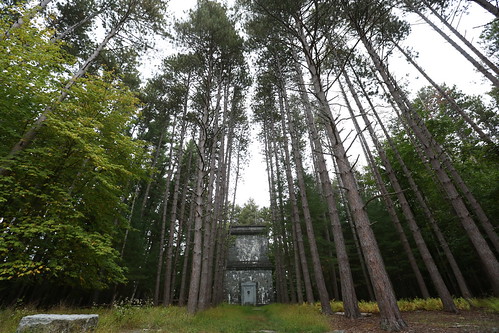FOR IMMEDIATE RELEASE 16-123 December 9, 2016 deppressoffice@dep.nyc.gov, (845) 334-7868 Department of Environmental Protection to Remove Hazard Trees Near Monument at Ashokan ReservoirProject is part of a long-term plan for public access at J. Waldo Smith monumentWork will require closing part of the recreation path until the end of 2016Historic and current-day photos of the monument can be found by clicking hereThe New York City Department of Environmental Protection (DEP) today announced that it will remove hazardous trees from the immediate proximity of a monument at Ashokan Reservoir beginning next week. The project is part of a long-term plan to enhance public access at the J. Waldo Smith Monument, a stone tower located on a hill along the south side of the reservoir. DEP will close a portion of the popular recreation path at Ashokan Reservoir to allow for the safe removal of century-old trees that are dead, dying, or within falling distance of the monument. That section of the trail, located between the monument and the Dividing Weir Bridge, is expected to be closed until the end of December. Signs will be posted at both ends of the closed area to inform walkers, joggers and cyclists. In the coming weeks, timber experts will remove trees within a 100-foot radius of the monument to prevent them from falling on the tower. Dead and dying trees will also be removed from a 9-acre area surrounding the monument. This tree thinning will open the forest floor to sunlight and promote the growth of a younger, more diverse forest to replace the conifer trees that have stood at that location for a century. It will also allow DEP to create a lawn area near the monument that can be used by the public. The removal of these trees is the first step in a long-term plan to restore the monument and establish public access at the site. The historic monument was built in 1908 as hundreds of workers constructed the dam, dikes, chambers and tunnels that would become Ashokan Reservoir. It was built atop Winchell Hill—a high point in the vicinity of the construction—and used as a triangulation tower to provide surveyors with an elevated and unimpeded view from which to take measurements. On Nov. 11, 1908, the tower was dedicated as the McClellan Monument. It was named after New York City Mayor George B. McClellan, who successfully pushed for the construction of Ashokan Reservoir, the Catskill Aqueduct, and the other reservoirs and infrastructure that comprise the City’s Catskills Water Supply System. McClellan traveled by automobile to Kingston the night before the dedication ceremony, and gave a speech to the assembled crowd the following day: “We have met here today to dedicate a triangulation tower,” he said,” not because it is a triangulation tower, nor because triangulation towers are of themselves beautiful, although this is an exception, but because this particular triangulation tower marks the middle point of the largest dam in the world, and because its dedication at this time marks the progress that has been made by the Water Supply Commission during the comparatively brief period of its existence.” In 1936, a memorial tablet was added to the monument in memory of J. Waldo Smith, the chief engineer for the Board of Water Supply, who directed construction of the Catskill System. When he died in 1933, Smith was remembered as a remarkable engineer whose expertise influenced the waterworks of many cities throughout the country, including Boston, Kansas City, San Francisco, Philadelphia and Baltimore. But the construction of New York City’s first water supply in the Catskills, hailed as a marvel of modern engineering, was considered his jewel. Still, he refused to accept credit for the work, noting to reporters that the system was made possible by his “splendid, loyal band of enthusiastic workers.” Although the tower at Ashokan was dedicated in McClellan’s name, it has been colloquially referred to as the J. Waldo Smith Monument for many years. The monument, now 108 years old, has fallen into disrepair, and the removal of hazardous trees is meant to prevent further damage. While DEP does not have an exact timeline for the work, the City does intend to restore the monument when the Dividing Weir Bridge and other facilities at Ashokan Reservoir are upgraded sometime over the next decade. DEP manages New York City’s water supply, providing more than one billion gallons of high quality water each day to more than 9.5 million New Yorkers. This includes more than 70 upstate communities and institutions in Ulster, Orange, Putnam and Westchester counties who consume an average of 110 million total gallons of drinking water daily from New York City’s water supply system. This water comes from the Catskill, Delaware, and Croton watersheds that extend more than 125 miles from the City, and the system comprises 19 reservoirs, three controlled lakes, and numerous tunnels and aqueducts. DEP has nearly 6,000 employees, including almost 1,000 scientists, engineers, surveyors, watershed maintainers and other professionals in the upstate watershed. In addition to its $70 million payroll and $157 million in annual taxes paid in upstate counties, DEP has invested more than $1.7 billion in watershed protection programs—including partnership organizations such as the Catskill Watershed Corporation and the Watershed Agricultural Council—that support sustainable farming practices, environmentally sensitive economic development, and local economic opportunity. In addition, DEP has a robust capital program with nearly $14 billion in investments planned over the next 10 years that will create up to 3,000 construction-related jobs per year. For more information, visit nyc.gov/dep, like us on Facebook, or follow us on Twitter. | ||
